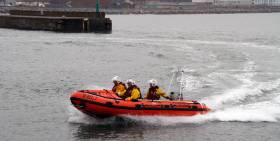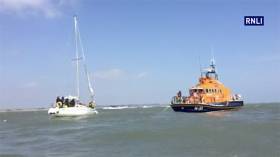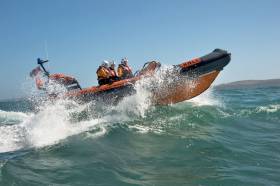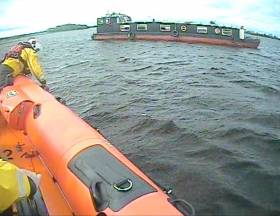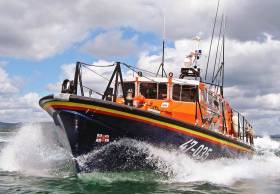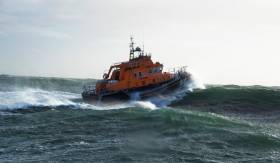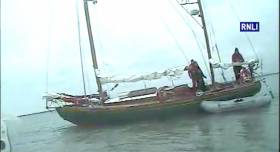Displaying items by tag: RNLI
Arklow RNLI responded to three consecutive call outs yesterday evening (Wednesday 3 May) bringing three yachts with eight onboard, safely to shore.
The volunteer crew who spent six hours at sea, was first requested to launch their all-weather lifeboat shortly before 4.30pm, following a report that a 23ft yacht was in difficulty somewhere near Arklow Bank.
The lifeboat under Coxswain Ned Dillon and with six crew members onboard proceeded to the scene and commenced a search in an area east of the bank. The Irish Coast Guard helicopter Rescue 117 from Waterford was also tasked.
Weather conditions at the time were favourable but there was a north east Force 5-6 wind blowing.
The lifeboat located the sailing vessel which was travelling from Fishguard to Belfast when its crew of three encountered difficulties, one mile east of Arklow Bank.
Having assessed the situation, Coxswain Ned Dillon decided to put a crew member onboard the vessel to assist with the rigging of a tow and to check if any medical assistance was required.
After ensuring the occupants of the boat were able to continue the trip, a towline was established and the lifeboat began to tow the vessel safely into Arklow.
As the lifeboat was completing the call, the crew was alerted once again and requested to go to the assistance of a 20ft yacht with two onboard which had got a rope tangled in its propeller. Once the crew of the first casualty vessel were safely brought to shore, the lifeboat immediately returned to sea and went to the sailors assistance. The lifeboat crew helped the sailors untangle the rope before towing the yacht into Arklow.
As the lifeboat crew were assisting the yacht, a third call for help came, this time to assist a 13m yacht with three onboard that had got into difficulty off Cahore Point off the Wexford coast. As Arklow RNLI was already at sea, the nearby Rosslare Harbour lifeboat was requested to launch.
The all-weather lifeboat from Rosslare under Coxswain Eamonn O’Rourke and with six crew onboard, set up a tow and commenced the passage towards Arklow. Once Arklow lifeboat had completed its second service of the evening, the crew returned to sea for a third time where they met the lifeboat from Rosslare. The tow was transferred and Arklow completed the tow back to the harbour.
Speaking following the call outs, Mark Corcoran, Arklow RNLI Volunteer Lifeboat Press Officer said: ‘It is unusual to have three back to back call outs in one evening but we were more than happy that we were able to return all three vessels and their crew safely to shore. It is on occasions like this evening where our skills and training, particularly those gained from joint training exercises with our colleagues at other lifeboat stations such as Rosslare, really kicks in and ensures we are ready to work together and assist each other in all conditions.
Mark reminded anyone taking to the sea during the good weather spell and on into the summer season to respect the water.
‘While we want everyone to enjoy the sea, we would encourage anyone planning a trip on the water to think safety first. Always wear a lifejacket and always have a means for calling and signalling for help. Always check the weather forecast and tide times. Make sure someone ashore knows where you are going and who to call if you don’t return on time’.
Wicklow RNLI to Name New Inshore Lifeboat
A new inshore lifeboat for Wicklow RNLI is to be officially named Dennis-Audrey during a ceremony at the lifeboat station at 4pm this Saturday 6 May.
The lifeboat which went on service in February this year was funded by Gladys Audrey Deakin who left her residuary estate to the RNLI for the funding of a lifeboat.
Audrey and her late husband Dennis loved holidays by the sea and were impressed by the work of the RNLI. It was their dream that their bequest be used to fund a lifeboat and that it would be named after them.
The donor will be represented by Audrey’s solicitor Michelle Gavin at the naming ceremony and service of dedication and she will officially hand the lifeboat into the care of the RNLI.
The honour of naming the lifeboat will go to Phylis Whyte, a former chair of the Wicklow RNLI fundraising branch.
Last year, Wicklow RNLI which also has an all-weather lifeboat launched 36 times and rescued 36 people. The all-weather Tyne class lifeboat Annie Blaker launched 21 times bringing 26 people to safety while the inshore lifeboat launched 15 times bringing 10 people to safety.
The new inshore lifeboat is replacing the Sheringham Shantymen, which was on service for 10 years at Wicklow RNLI. The lifeboat which was named after the Sheringham Shantymen was funded by money raised at their concerts. During its time in Wicklow, the lifeboat rescued 96 people, seven dogs and a farmer’s sheep.
Speaking ahead of Saturday’s naming ceremony, Des Davitt, Wicklow RNLI Lifeboat Operations Manager said: ‘The naming ceremony and service of dedication is a special occasion for our lifeboat station and we are grateful to Audrey and Dennis who generously funded our new lifeboat.’
First introduced into the RNLI fleet in 1963, the design of the inflatable D class lifeboat continues to evolve to meet changes in demand and technology.
It is the workhorse of the RNLI’s fleet and is ideal for working close inshore, near rocks or in shallow water in moderate conditions. It can be righted by the crew if it capsizes and is also part of the RNLI Flood Rescue Teams fleet of boats.
A highly manoeuvrable lifeboat, the D class can operate closer to shore than Wicklow’s all-weather lifeboat and comes into her own for searches and rescues in the surf, shallow water and confined locations - often close to cliffs, among rocks and even inside caves.
A lifeboat station was established in Wicklow in 1857. The first lifeboat was a 30ft rowing boat.
In 1911 the boathouse was adapted and the station’s first motor lifeboat, the first for Ireland, arrived.
In 1989, the boathouse was adapted once again and the slipway extended for the station's new Tyne class lifeboat. The adaptation to the boathouse included improved crew facilities and additional extensions for the refurbished winch and a souvenir sales outlet. The slipway was extended by 24 metres.
A D class lifeboat first went on service in Wicklow in 1995 with a new boathouse extension for housing the lifeboat completed in 1997.
The RNLI is a charity which relies on voluntary contributions and legacies.
Stranded Yacht Towed To Safety By Howth Lifeboat
#RNLI - Howth RNLI launched its all-weather and inshore lifeboats yesterday (Monday 1 May) to reports of a sailing yacht with steering failure at the entrance to Malahide Estuary.
The inshore lifeboat was first on scene and located the casualty vessel just after noon. The 30ft sailing yacht, with five people aboard, was experiencing steering problems and unable to safely manoeuvre.
Weather conditions at the time had a moderate sea state in Force 4-5 winds.
The all-weather lifeboat arrived on scene shortly after and secured a towline to the stricken yacht before towing it to the safety of Howth Marina.
Both the inshore and all-weather lifeboats returned to station and were stood down following the successful rescue.
Speaking after the callout, Howth RNLI duty coxswain Ian Sheridan said: “We were delighted to assist the five crew of the sailing yacht after they found themselves with no steering at the entrance to Malahide Marina.
“They quickly radioed for assistance which was the correct thing to do and we were able to launch and tow the yacht to safety.”
#RNLI - Baltimore RNLI’s inshore lifeboat was launched on Saturday night (29 May) to assist a boat that had broken from its moorings in Baltimore Harbour.
Concerned for the safety of a person seen trying to access the boat from a rowing dinghy in strong southerly winds, a member of the public raised the alarm, and the ILB was tasked to assist, quickly returning the boat it its morning and its occupant back to shore.
On return to station, the lifeboat was tasked to investigate a possible flare sighting in the area.
After conducting a search in strong wind, rain and darkness, nothing was out of the ordinary was found and the ILB was stood down.
The Baltimore lifeboat crew on this callout were Mícheál Cottrell, Ryan O’Mahony and Colin Rochford, with Seamus O’Driscoll, Rianne Smith and Jerry Smith on shore and Brian McSweeney also in attendance.
#RNLI - Lough Ree RNLI’s lifeboat crew were alerted by the Irish Coast Guard yesterday morning (Saturday 29 April) when a 56ft barge with three people on board ran hard aground on rocks close to Blackwood Point, at the northern end of Lough Ree.
Shore crew Tony Diskin, Matt Harte, Billy Henshaw and Dennis Buckley responded quickly when the alarm was raised shortly before 10 am and got the inshore lifeboat The Eric Rouse launched and underway in less than ten minutes, with first responders Kieron Sloyan, Kieran Scullion and Liam Sherringham on board.
A short time later, the lifeboat crew was alongside the casualty vessel, checking that all on board were safe and well. Weather conditions at the time were dry, with strong Force 5-6 wind and a rising swell with waves up to a metre high.
After checking that the vessel was not taking on water, a tow line was established and the vessel was safely towed to deeper navigable water.
Crew member Kieran Scullion remained aboard the barge to check that all systems were operating normally and to assist with navigation on the journey north to Lanesborough Quay, accompanied by the lifeboat. Upon arrival at Lanesborough, the crew ensured that the barge was securely berthed before departing the scene.
On return to the lifeboat station, the crew observed a hire vessel straying outside the navigation channel between Clawinch Island and Quaker Island.
The crew diverted course to the hire vessel and guided the occupants back to safe water. A lifeboat crew member was invited on board the vessel and spent some time assisting the hire vessel crew in identifying the navigable areas of the lake.
The lifeboat crew also advised the occupants of the difficult conditions further south, whereupon the hire vessel decided to return north to Ballyleague Harbour until conditions for crossing the lake improved.
Speaking following the callout, Lough Ree RNLI lifeboat operations manager Tony McCarth said: “It was a busy day for the lifeboat on Lough Ree and we were delighted to be able to assist.
“As we continue to enjoy this Bank Holiday weekend and as we look forward to the main boating season starting, we would like to remind everyone planning a trip on the lake to respect the water.”
Wicklow Lifeboat Assists Fisherman Adrift Near Kiloughter Beach
#RNLI - Wicklow RNLI's all-weather lifeboat launched at 10.52am yesterday morning (Saturday 29 April) to search the bay for a missing fisherman.
The lifeboat, under the command of coxswain Nick Keogh with a volunteer crew, proceeded north to the fisherman’s last known position.
Weather conditions in the area at the time were described as moderate seas with a south-easterly Force 4 wind.
Twelve minutes after launching, the lifeboat crew located the man in his small boat near Kiloughter beach, in what Keogh described as “choppy” seas.
A quick assessment found he was unable to get back to Wicklow Harbour due to mechanical problems with the outboard engine.
The boat was taken in tow back to the garbour, where the fisherman was landed safely ashore just before midday.
“We were happy to assist him,” Keogh added.
Rosslare Harbour Lifeboat Assists Two On Yacht Off Tuskar Rock
#RNLI - Rosslare Harbour RNLI volunteers launched their all-weather lifeboat in the early hours of this morning (Friday 28 April) following a call for help from a yacht with two men onboard off Tuskar Rock.
The 15m yacht broke its mast on a passage from Kinsale to Howth, some four miles south of Tuskar Rock Lighthouse.
The two men onboard, who are experienced sailors, decided not to run the engine for fear of fouling the propeller due to the amount of rigging and rope in the water.
They were quick to call for help, and the Irish Coast Guard requested the all-weather lifeboat from Rosslare Harbour to launch at 12.40am.
Weather conditions at the time was favourable, with a moderate sea swell and a northerly wind of Force 3 to 4.
Once on scene, the lifeboat crew towed the sailing vessel into the shelter of Rosslare Europort, where it was tied up at 4am.
Speaking following the callout, Rosslare Harbour RNLI volunteer lifeboat press officer Jamie Ryan commended the quick action of the two crew aboard the yacht.
“They did the right thing this morning and raised the alarm when they started to encounter problems. Our volunteers responded rapidly and we were delighted to help the vessel and her crew safely to shore.”
Ryan added: “We would remind anyone taking to the sea over the Bank Holiday weekend and on into the main boating season to respect the water.
“Always carry a means of calling for help and keep it within reach. Wear a personal floatation device. Check the weather and tides. Tell someone elsewhere you are going and when you will be back. Wear appropriate clothing for the conditions and your trip.”
Only 21% of Lifejackets 'Free of Faults': Dun Laoghaire RNLI Issue Lifejacket Safety Warning At Ireland's Biggest Boating Centre
Dun Laoghaire RNLI is making a timely warning this Bank Holiday weekend to all lifejacket owners to ensure the appropriate safety checks are carried out by a competent agent ahead of the main boating season.
The safety appeal comes following the results from a free lifejacket advice clinic held in Dun Laoghaire by the RNLI’s community safety team last weekend.
Of the 131 lifejackets checked, only 21% were found to be completely fault free.
The lifejackets were brought to the free clinic by a variety of boat users and were checked by experienced RNLI volunteers. While the RNLI offers sea safety advice it does not offer a pass or fail assessment on lifejacket servicing.
Just over half the units tested had the recommended crotch straps fitted that are considered vital to ensure that a lifejacket inflates correctly on the wearer and remains in place, keeping the wearer’s head above the water and helping to prevent fatigue.
There were numerous examples of life-threatening problems detected during the checks. Ninety of the units had out of date firing mechanisms and 23 had corroded gas bottles that risk incorrect inflation in an emergency.
Speaking following the clinic, Stephen Wynne, Dun Laoghaire RNLI Lifeboat Operations Manager said: ‘Although we are very pleased that more than 100 lifejackets were checked, the fault rate is extremely worrying when you think that anyone taking to the water needs and relies on a lifejacket should they get into trouble. As the main boating season gets underway, we are appealing to everyone thinking of going on the water to ensure that they not only have a lifejacket but that every user has their lifejacket checked by a competent agent. This is so important and could save a life.’
Other problems identified at the clinic included lifejackets that had already been fired (3), missing gas cylinders (3), missing firing mechanisms (3), bladder abrasion (3), holed bladder (3) and one unit that was so old it didn't inflate at all.
‘It is essential that the correct type of lifejacket is used depending on the planned activity’, added Peter Richardson, Dun Laoghaire RNLI Community Safety Officer. ‘Specialist activities such as offshore racing or cruising need lifejackets fitted with a spray hood, light and space for a personal locator beacon (PLB). People who do not fit a crotch strap to their lifejacket or who do not use it when fitted is risking their lives should they end up in the water’.
Missing Toddler Report Prompts Bangor Lifeboat Launch
#RNLI - Bangor RNLI’s volunteers launched the inshore lifeboat Jessie Hillyard yesterday evening (Monday 24 April) to reports of a missing three-year-old in the vicinity of the Jamaica Inn.
Setting off in big breaking seas and a Force 8 gusting wind, helmsman Kyle Marshall and crew John Bell and Johnny Gedge made their way to Luke’s Point.
En route, the information was changed to a seven-year-old boy who had run off from his parents’ car.
With Donaghadee RNLI getting ready to launch, and the PSNI and HM Coastguard in attendance on land at Luke’s Point, Bangor RNLI were informed that the boy was found to have made his own way home and was safe.
Commenting on the callout, Marshall said: “The crew and I are delighted that this young lad has been found safe and is back with his family. Conditions were challenging this evening, but this is what we are trained to handle.
“There is no substitute for experience on a call like this, and keeping the crew safe is a top priority. In high seas and strong winds, ‘softly softly catchy monkey’ is the way to go.”
Yacht on Sand Bank with Three Onboard Brought to Safety by Rosslare Harbour and Wexford RNLI (Video)
A 39ft–wooden yacht with three people onboard was brought to safety by Wexford and Rosslare Harbour RNLI in County Wexford yesterday evening.
Volunteer lifeboat crew from both stations were requested to launch just before 7.30pm following a report that a yacht had got into difficulty off Wexford Bar.
The 1925 ketch with three onboard was on passage from Scotland to the south coast of England when it got stranded on a sand bank in the mouth to Wexford Harbour.
The inshore lifeboat from Wexford and the all-weather lifeboat from Rosslare were launched along with the Irish Coast Guard helicopter Rescue 117 from Waterford.
Weather conditions at the time were described as fair with a Force 2-3 west to south westerly wind and a smooth sea state.
Once on scene at 7.38pm, the lifeboat crew observed that the vessel had damaged its steering gear and was stuck in a shallow area of Wexford Harbour. The crew from Wexford RNLI proceeded to take a tow line from Rosslare’s lifeboat and pass it to the sailors of the vessel.
Using their training, both lifeboat crews worked together to release the yacht. The inshore lifeboat was able to use its shallow draft to manoeuvre the casualty and tow the vessel into deeper waters while the power of the Rosslare all-weather lifeboat ensured the tow was carried out effectively. Once in safer waters, Rosslare RNLI then towed the vessel to Rosslare Port where it was safely secured at 9.45pm.
Speaking following the call out, Lorraine Galvin, Wexford RNLI Volunteer Lifeboat Press Officer said: ‘This call out involved teamwork with our colleagues from Rosslare Harbour RNLI as we worked together and depended on each other to successfully release the yacht. The sailors did the right to raise the alarm when they started to encounter problems because time was of the essence. While the water may have appeared flat calm, in another couple of hours things could have changed dramatically in that area of the harbour.’



























